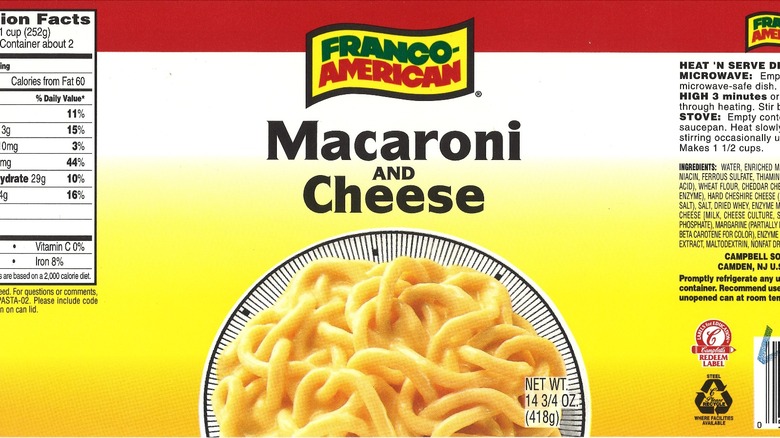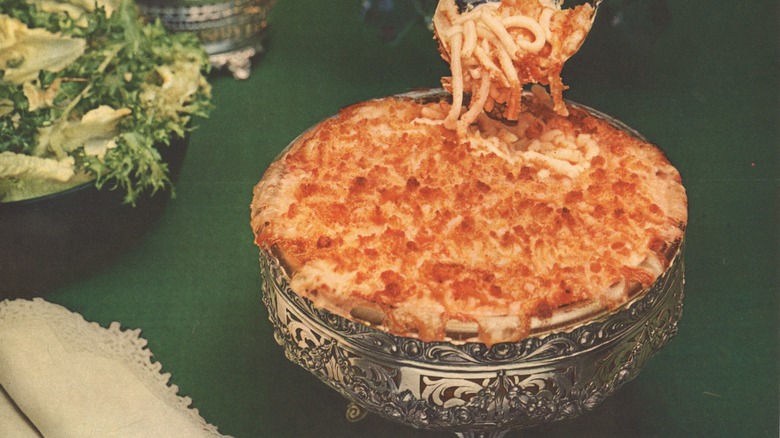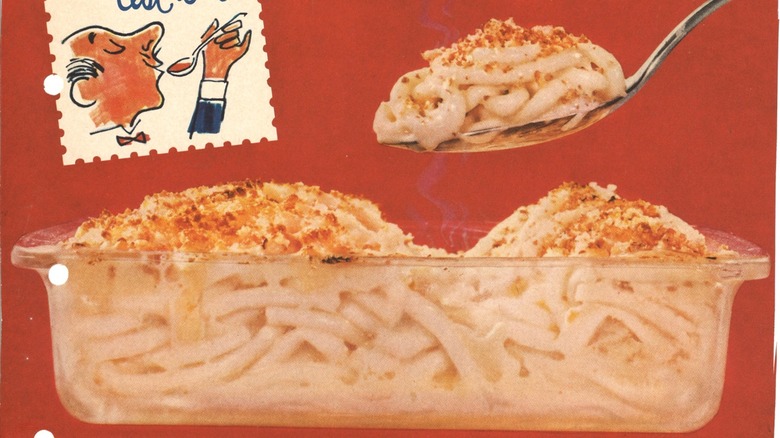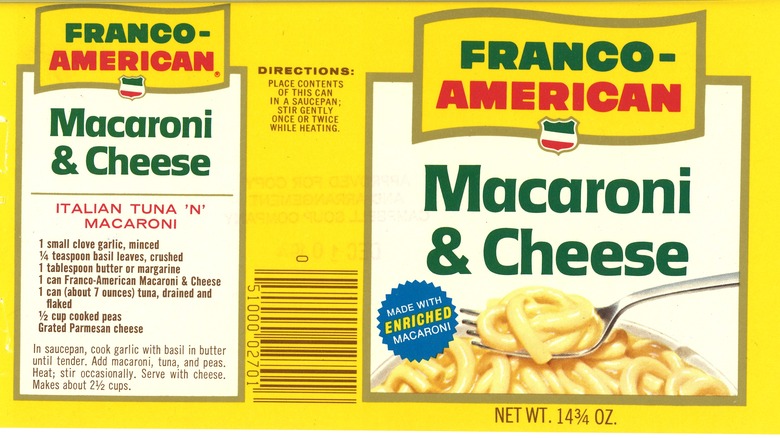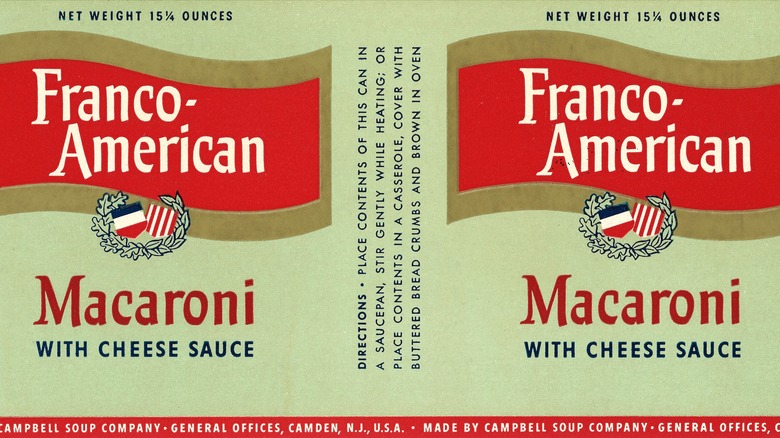The Canned Mac And Cheese That Didn't Stand The Test Of Time
How do you take your mac and cheese – in a tub, from a box, made from scratch, or do you go all-out and order it from a restaurant? One way you probably don't eat it is from a can, since canned macaroni and cheese, while it still exists, is somewhat of a rarity. Once upon a time, that time being the 20th century, the stuff was actually pretty popular. One of the biggest brands of the time, though, is something you will likely never see again: Franco-American.
Mashed spoke with the Campbell's Soup Company archivist, and she told us that Franco-American macaroni with cheese sauce was first introduced in 1939, but that it temporarily went out of production just a few years later, most likely because of World War Two-related rationing of either ingredients or materials to make the cans. It returned in 1949, however, and seems to have been a pretty popular product during the latter half of the 20th century. Alas, like many other once-popular foods (anyone remember Chun King egg rolls or Jolt Cola?), it failed to find its niche in the new millennium.
It even had a celebrity spokesperson
When Franco-American macaroni with cheese sauce returned to store shelves in post-war America, the company could promote it with the aid of the Campbell Test Kitchens, which had opened in 1941. Professional home economists, as they were known at the time, came up with new ways to use the numerous different Campbell's soup products in out-of-the-can recipes such as green bean casserole and tomato soup cake. The macaroni and cheese too, came in for such treatment as in this 1962 advertisement featuring a recipe for "macaroni 'n' sausage Italienne" where the product is mixed with sauteed onions, peas, dried oregano, and small sausage links (possibly the breakfast kind). In one 1959 TV ad, a famous face showed off the canned mac and cheese in a less doctored-up form.
The ad opens up in a "home kitchen" that looks as perfect as only one on a TV sound stage can do. When the equally perfect, pearl-wearing '50s housewife turns toward the camera, she introduces herself as actress June Lockhart. While she would later be known for roles in mid-century TV series "Lost in Space" and "Petticoat Junction," she was at that time starring in "Lassie" (and Campbell's was one of the show's sponsors). Lockhart played the mom of Little Timmy and while she was waiting for the collie to rescue the kid from one of those wells he kept falling into, she apparently whiled away the time whipping up pseudo-home-baked canned macaroni with a crumb topping.
Its shape made it stand out in a sea of other pasta products
One thing about Franco-American macaroni and cheese that made it look different from most other types of macaroni and cheese on the market, then and now, is the noodles used to make it. Macaroni and cheese is often made with elbow macaroni, sometimes with shells, and even with rotini. However, Franco-American's canned mac and cheese contained long noodles similar to the ones used in spaghetti.
The Campbell's archivist tells us that no one really seems to know exactly why the Franco-American brand made this product with spaghetti noodles. The company's best guess, however, is that doing so probably made it easier to produce. After all, the same noodles could be split between the mac and cheese and the brand's canned spaghetti, a product that's been around since the 1890s and is still in Cambell's canned product lineup today. Franco-American did introduce an alternate, more traditional, form of canned elbow macaroni and cheese in the '80s, but that, too, is no longer around.
The name changed in the '70s and again in the '00s
As with many products that have been around for a while, Franco-American's canned macaroni and cheese underwent a number of different label re-designs over the years. Twice, however, it actually adopted a different name. The first change, which took place in the early '70s, was when the product formerly known as Macaroni with Cheese Sauce was re-branded as Macaroni & Cheese. Pretty minor, as such things go, but it did bring the name more in line with modern usage.
The second name change, however, was a biggie. Even though the Franco-American brand had been owned by Campbell's since 1915, the company chose to group its pasta products under the former name so as to differentiate them from its other offerings. In 2004, however, the Franco-American name went away ... well, sort of. While the name Franco-American on the front of the cans was replaced with a Campbell's, the backs featured a smaller version of the old logo.
It no longer seems to be available under any name
While Franco-American Macaroni & Cheese under that name may have disappeared from stores in 2004, the product itself lasted a while longer under the Campbell's moniker. Sometime over the last two decades, however, canned mac and cheese seems to have quietly dropped off the Campbell's product roster. The company still offers multiple kinds of canned pasta, including 13 different varieties of Spaghetti-Os, as well as spaghetti with long noodles. It no longer has anything resembling mac and cheese either in or out of a can.
We can't say for sure when Campbell's Macaroni & Cheese went away, but it would seem to be some time prior to 2019 since that's the date of a Change.org petition demanding its return. So far, just over 1,000 people have signed it, which is approximately 0.0003% of the U.S. population. Why so few? Well, if an r/genX Reddit thread is anything to go by, the stuff just wasn't all that great. One commenter not-so-nostalgically recalls it as "disgusting" while another says the thought of it "make[s] my stomach squirm." Yet a third unfondly reminisces about puking the one time they tried it, while about the most ringing endorsement comes from a person who says they'd consider eating it only if it was the only thing left in the pantry. Sorry, Timmy's mom! Looks like Campbell's mac and cheese fell down a well, too, and even Lassie's not interested in hauling it back out again.
